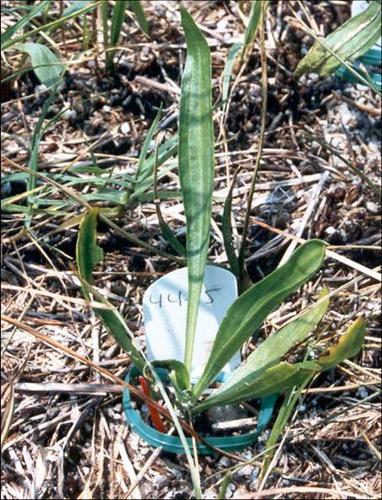当前位置:
X-MOL 学术
›
Funct. Ecol.
›
论文详情
Our official English website, www.x-mol.net, welcomes your
feedback! (Note: you will need to create a separate account there.)
Life history trade‐offs and senescence in plants
Functional Ecology ( IF 4.6 ) Pub Date : 2019-10-18 , DOI: 10.1111/1365-2435.13461 Deborah A. Roach 1 , Erin F. Smith 1
Functional Ecology ( IF 4.6 ) Pub Date : 2019-10-18 , DOI: 10.1111/1365-2435.13461 Deborah A. Roach 1 , Erin F. Smith 1
Affiliation

|
An increasing number of studies have shown that senescence, the functional decline in traits and increased risk of mortality with increasing age, occurs in organisms in wild populations, but there is a wide range of diversity in the patterns of senescence across species. The antagonistic pleiotropy and the disposable soma theories of senescence predict that there will be life‐history trade‐offs between performance at early‐ and late‐life stages. Plants show variation in senescence patterns and thus provide an opportunity to evaluate life‐history trade‐offs and senescence. Many plant species can be easily followed demographically and their environments, resources and allocation to reproduction can be manipulated, which makes them particularly good models to address these questions. We compared the results from 22 studies of plant senescence in the wild and compiled 20 examples of life‐history trade‐offs in plants. Some of the unique features of plants that may influence senescence patterns and trade‐offs in the wild are highlighted through the results. We found all three age‐specific patterns: age decline, age improvement and no change with age for plants in the wild. Most species showed an age‐dependent decline in at least one trait but, even within a species, the age‐specific patterns of traits varied. Results also showed that trade‐offs vary across environments and that plants can manipulate their resource pool through increases in photosynthesis, which will influence the manifestation of trade‐offs. We conclude that aspects of plant biology including dynamic resource pools, the impact of size, dormancy and below‐ground storage may influence both the patterns of senescence and life‐history trade‐offs. The diversity of plant life forms and life cycles provide a wealth of opportunities to experimentally study senescence in the context of life‐history trade‐offs. A free Plain Language Summary can be found within the Supporting Information of this article.
中文翻译:

植物的生命史权衡和衰老
越来越多的研究表明,衰老、性状功能下降和随着年龄的增加死亡风险增加,发生在野生种群的生物中,但不同物种的衰老模式存在广泛的多样性。衰老的拮抗多效性和一次性体细胞理论预测,在生命早期和晚期阶段的表现之间将存在生命史权衡。植物表现出衰老模式的变化,因此提供了评估生活史权衡和衰老的机会。许多植物物种可以很容易地在人口统计上进行追踪,并且可以操纵它们的环境、资源和繁殖分配,这使得它们成为解决这些问题的特别好的模型。我们比较了 22 项野生植物衰老研究的结果,并汇编了 20 个植物生命史权衡的例子。结果突出了可能影响野生环境中衰老模式和权衡的植物的一些独特特征。我们发现了所有三种特定于年龄的模式:野生植物的年龄下降、年龄改善和不随年龄变化。大多数物种至少在一个性状上表现出年龄依赖性下降,但即使在一个物种内,性状的年龄特异性模式也各不相同。结果还表明,权衡因环境而异,植物可以通过增加光合作用来操纵其资源库,这将影响权衡的表现。我们得出结论,植物生物学的各个方面,包括动态资源库、大小的影响、休眠和地下储存可能会影响衰老模式和生活史权衡。植物生命形式和生命周期的多样性为在生命历史权衡的背景下实验研究衰老提供了丰富的机会。可以在本文的支持信息中找到免费的普通语言摘要。
更新日期:2019-10-18
中文翻译:

植物的生命史权衡和衰老
越来越多的研究表明,衰老、性状功能下降和随着年龄的增加死亡风险增加,发生在野生种群的生物中,但不同物种的衰老模式存在广泛的多样性。衰老的拮抗多效性和一次性体细胞理论预测,在生命早期和晚期阶段的表现之间将存在生命史权衡。植物表现出衰老模式的变化,因此提供了评估生活史权衡和衰老的机会。许多植物物种可以很容易地在人口统计上进行追踪,并且可以操纵它们的环境、资源和繁殖分配,这使得它们成为解决这些问题的特别好的模型。我们比较了 22 项野生植物衰老研究的结果,并汇编了 20 个植物生命史权衡的例子。结果突出了可能影响野生环境中衰老模式和权衡的植物的一些独特特征。我们发现了所有三种特定于年龄的模式:野生植物的年龄下降、年龄改善和不随年龄变化。大多数物种至少在一个性状上表现出年龄依赖性下降,但即使在一个物种内,性状的年龄特异性模式也各不相同。结果还表明,权衡因环境而异,植物可以通过增加光合作用来操纵其资源库,这将影响权衡的表现。我们得出结论,植物生物学的各个方面,包括动态资源库、大小的影响、休眠和地下储存可能会影响衰老模式和生活史权衡。植物生命形式和生命周期的多样性为在生命历史权衡的背景下实验研究衰老提供了丰富的机会。可以在本文的支持信息中找到免费的普通语言摘要。











































 京公网安备 11010802027423号
京公网安备 11010802027423号